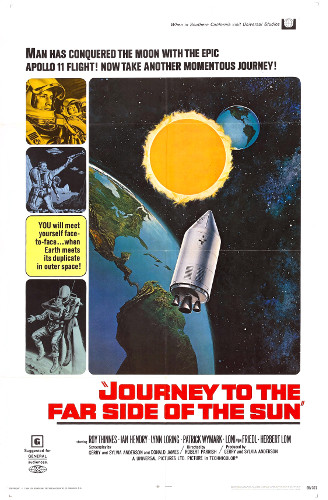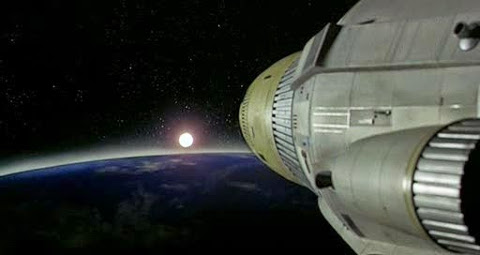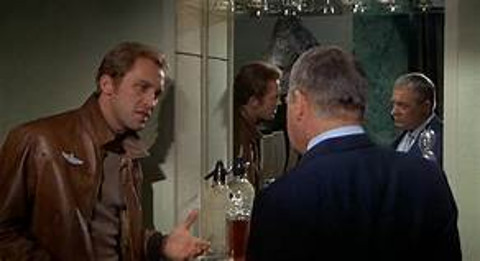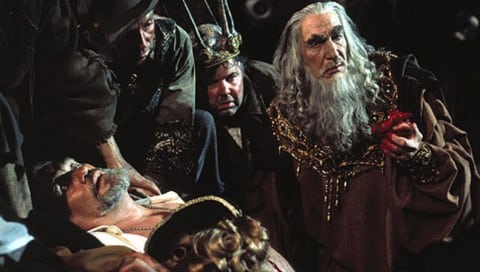Journey to the Far Side of the Sun (1969)
Directed by: Robert Parrish
Written by: Donald James, Gerry Anderson, Sylvia Anderson, Tony Williamson
Starring: Ian Hendry, Lynn Loring, Patrick Wymark, Roy Thinnes
AKA DOPPELGANGER
USA
AVAILABLE ON BLU-RAY AND DVD
RUNNING TIME: 105 mins
REVIEWED BY: Dr Lenera
A planet is discovered in the same orbit as Earth’s but located on the exact opposite side of the sun. European Space Exploration Council Command chief Jason Webb has difficulty convincing space agencies to fund an exploratory mission until a breach in security raises fears that “the other side” will get there first. American astronaut Glenn Ross and British scientist John Kane are sent to explore the other planet after much rigorous training. After a disastrous crash-landing Ross awakes to learn that Kane lies near death and that they apparently have returned to Earth – or have they?
What’s in a title? This film goes under two monikers and the more widely used one today is simpler and gives more of an idea of the premise, but Doppleganger is more poetic and perhaps even more appropriate seeing as it’s really a slightly disguised sci-fi variation of the doppleganger myth, where a person has a double which is usually a bringer of bad luck and worse. It’s an idea that’s always fascinated and frightened me, especially in that episode of The Hammer House Of Horror TV series which scared and haunted so many who saw it. A month or so ago I reviewed Arrow’s Blu-ray release of the Japanese sci-fi Warning From Space; it having the first usage of the idea of a planet in our solar system undiscovered until now because it’s on the opposite side of the sun and has the same orbit as Earth’s prompted me to revisit this 1969 curio. It made a strong impression as a young child because of its premise and its downbeat finale, which, if not quite as depressing as the one in the same year’s Beneath The Planet Of The Apes where the whole friggin’ world was blown to smithereens, still packs a punch and taught me at the time that things don’t always end well. This production from Jerry and Sylvia Anderson is a little stiff, as if the Andersons’ were a bit too used to filming puppets in the likes of Thunderbirds, and probably doesn’t take its ideas as far as a modern version may do, but its special effects are almost as impressive as the previous year’s 2001: A Space Odyssey, and despite it being heavy on dialogue and low on action, I wasn’t ever bored with the sombre tale unfolding in front of me.
Assisted by Tony Williams, the Andersons’ wrote a screenplay that was originally planned as a one-hour drama for TV. Producer Jay Kanter insisted that novelist Donald James be hired to improve characterisation; he also changed some things including swapping the characters of Ross and Kane. Gayle Hunnicutt was supposed to play Sharon but left after falling ill; Lynn Loring, star RoyThinnes’ then wife, replaced her. Thinnes [Ross] was playing a heavy smoker so he lit up a huge number of cigarettes for real; it damaged his health so he demanded a non-smoking clause in his next film contract. Ian Hendry [Kane] was always drinking and performed some scenes drunk, and Patrick Wymark [Jason Webb] was also pissed throughout, requiring take after take. Eventually director Robert Parrish decided to shoot their more difficult scenes in the morning before they got too blotto. There was much arguing on set, including Parrish refusing to film scenes from the script he deemed to be nonessential, and cinematographer John Read not wanting to reshoot shots of the spacecraft so it was moving in a straight line; Read resigned. After filming completed in and around Pinewood Studios, the movie was held up for a year by an unenthusiastic Universal. Doppleganger was the original title, but it was renamed Journey to the Far Side of the Sun in the US and Australia and most versions have since been called that. It was a box office failure. Some TV broadcasts of the film showed a flopped picture due to a a telecine operator believing that the scenes set on the Counter-Earth had been wrongly reversed and therefore inverted them to correct the supposed error!
We open with Herbert Lom as a spy breaking into the EUROSEC headquarters with another guy, and I’d forgotten that this actor whom I always enjoy was in this, though he wasn’t in it for long sadly. After getting past security, Lom’s character Kurt Hassler removes a prosthetic eye pre-Terminator and uses it to photograph secret documents. These documents contain details of this planet that a probe has located, and are transmitted to some un-named country in the East; for some reason they didn’t want to mention the Soviet Union or China, but the EUROSEC organisation sort of prefigures the European Union; it even has a similar logo. Hassler is hunted down and shot dead, but the need to get this mission underway is still urgent. We’ve already had “two manned missions to Mars”, so it shouldn’t be too difficult. Glenn Ross seems to be the man for the job, and we know he’s supposed to be cool because he sometimes wears his sunglasses indoors, though a row with his wife Sharon shows him almost choking her then slapping her hard; this suggests a darker side to his character that’s only followed through slightly, while the subject of the row – her being discovered to be taking contraceptives after accusing him of being sterile – is never ever referred to again. And a much later flashback scene contains shots from the row scene which don’t appear in the scene proper! It was probably right to cut out much of the soapy material, but it’s very obvious that the finished product contains heavy editing.
Ross and scientist John Kane prepare for the expedition, and then the immediate preparation and launch is lingered upon in a way that it probably wouldn’t be today, though as a kid mad on space travel I found it rather exciting back in the day. Their travel through space is one of the best sequences of its kind in its time, with the mostly convincing model work and backgrounds, mildly psychedelic imagery and beautiful music scoring by Barry Gray combining to create something highly atmospheric, even almost serene. When Ross and Kane wake up, they actually discuss whether to land on this planet or not, something rarely seen; normally characters in movies take this giant step with no hesitation. The landing doesn’t go well and Kane is badly injured in the process. The film is quite clever here; all we initially see of this planet and its inhabitants are a rocky surface, then a search light eerily appearing over the wreckage and the silhouette of a human-shaped being behind it. Of course they’re actually back on Earth – or so it seems that way at first. EUROSEC chief Jason Webb thinks that Ross either aborted the mission or genuinely thinks that he made it to this other planet. But then it begins to occur to Ross that he actually isn’t on Earth at all, because everything seems to be a mirror image of what it should be; cars drive on the wrong side of the road, text is back to front, and so forth. But who will believe him? The plotting does seem to rely on its characters being slow; for example, surely Ross showing Webb his reversed clothing, even body marks, would be an obvious thing to do? Why doesn’t Ross just show him an image of his orbiting spacecraft’s reversed insignia instead of trying to do what he does with it? And, come to think of it, shouldn’t everyone on Counter-Earth be speaking backwards? Still, the brave, bleak ending is certainly appropriate, with the haunting if clearly 2001-inspired final scene being one that will stick in the mind even if it possibly raises some more questions.
We’re never told what year all this is taking place in, but the depiction of the future is sort of a cross between the ones in Fahrenheit 451 and Gattaca where – despite a few odd details – things aren’t that different from the present [or should I say what was the present when the films were made], and the likes of Logan’s Run and Things To Come where people swan around in garish costumes in a very sterile environment. Of course this being a ’60s film the women still look they’re straight out of the ’60s. Budgetary considerations no doubt required that our main glimpse of what this world is like being a view out of a window where we see a [pretty good] matte painting of tall tower blocks with lots of space between them in rather too orderly-looking countryside. There are some neat details, like a flight ending with the craft disassembling itself on the runway so that the passenger section is carted separately for disembarking, and watches which monitor everyone’s vital stats and remind them to take their medication [this may not be far away from now]. For the Counter-Earth scenes, instead of building elaborate reversed sets and pops, they simply flipped over the film negative. This works fine; only a few errors remain, like the machines controlling Ross and Kane’s vital functions aboard Phoenix first being shown connected to their left wrists, then their right. The EUROSEC board holding a videoconference on several high-resolution viewing monitors required the use of colour TVs which in 1969 were extremely rare and extremely expensive, so instead they cut screen-sized holes in a wall and placed the actors playing the conference delegates behind them, while silver paper was added to reflect the studio lights and simulate a high-resolution image.
While a few optical shots are obviously very grainy, it’s amazing how good most of the special effects, done by Derek Meddings of 007 fame but working on a far smaller budget, still look, especially considering how they’re lingered upon at length. There are even a few beautiful shots, like the sun rising in space above both the Counter-Earth and the spacecraft. Parrish’s fairly static direction relies primarily on lengthy zooms into characters to provide some fluidity, while it’s quite obvious that Hendry is pissed in certainly two scenes. Thinnes is okay if a tad stolid at times; it’s Wymark who steals the show acting-wise. Barry Gray’s score piles on the drama in places but is quite sparsely paced. It sometimes employs the ondes martenot, an early electronic instrument often used by Elmer Bernstein. The main premise of Journey To The Far Side Of The Sun was silly even in 1969; there’s no way a whole planet would have remained undetected for so long because it would be causing gravitational flutters in the motions of other planets; this was how Pluto was discovered. And because it’s half way before we get to Counter-Earth, there’s no room to really delve into the potential of the premise, let alone explore the philosophical possibilities, while Ross’s romance there with EUROSEC worker Lise is another thread that come to little. However, this is still a film which is easy to respect, an attempt at a more cerebral type of sci-fi movie at a time when, 2001 notwithstanding, they were rarely made. Quest For Love and Another Earth were two better films that played with some of its ideas, but Journey To The Far Side Of The Sun can still provoke thought and chill.








Wow Doc, thanks for the review!
This is one of those films I saw as a kid, and will never forget….. aah youth, before you get jaded and cynical.
Great review of what I thought was a great film (at the time) Not sure what I would think now, but hey was nice to be reminded. The mention of Fahrenheit 451 also woke some nice memories. I better stop, starting to blab.
Richard
Thanks for your kind comment. It was really nice to read that the review awoke some nice memories! Revisiting films one loved as a kid can sometimes result in disappointment, though thankfully that has only happened a few times to me, and it’s always an interesting exercise.